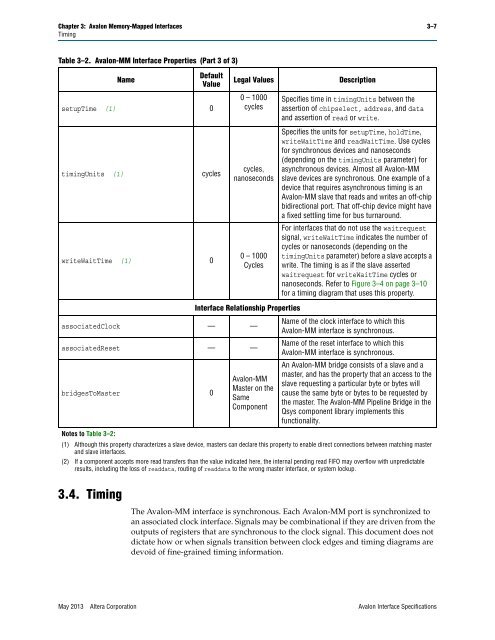Avalon Interface Specifications (PDF) - Altera
Avalon Interface Specifications (PDF) - Altera
Avalon Interface Specifications (PDF) - Altera
You also want an ePaper? Increase the reach of your titles
YUMPU automatically turns print PDFs into web optimized ePapers that Google loves.
Chapter 3: <strong>Avalon</strong> Memory-Mapped <strong>Interface</strong>s 3–7<br />
Timing<br />
Table 3–2. <strong>Avalon</strong>-MM <strong>Interface</strong> Properties (Part 3 of 3)<br />
setupTime (1) 0<br />
timingUnits (1) cycles<br />
writeWaitTime (1) 0<br />
3.4. Timing<br />
0 – 1000<br />
cycles<br />
cycles,<br />
nanoseconds<br />
0 – 1000<br />
Cycles<br />
<strong>Interface</strong> Relationship Properties<br />
associatedClock — —<br />
associatedReset — —<br />
bridgesToMaster 0<br />
Notes to Table 3–2:<br />
Name<br />
Default<br />
Value<br />
Legal Values Description<br />
<strong>Avalon</strong>-MM<br />
Master on the<br />
Same<br />
Component<br />
Specifies time in timingUnits between the<br />
assertion of chipselect, address, and data<br />
and assertion of read or write.<br />
Specifies the units for setupTime, holdTime,<br />
writeWaitTime and readWaitTime. Use cycles<br />
for synchronous devices and nanoseconds<br />
(depending on the timingUnits parameter) for<br />
asynchronous devices. Almost all <strong>Avalon</strong>-MM<br />
slave devices are synchronous. One example of a<br />
device that requires asynchronous timing is an<br />
<strong>Avalon</strong>-MM slave that reads and writes an off-chip<br />
bidirectional port. That off-chip device might have<br />
a fixed settling time for bus turnaround.<br />
For interfaces that do not use the waitrequest<br />
signal, writeWaitTime indicates the number of<br />
cycles or nanoseconds (depending on the<br />
timingUnits parameter) before a slave accepts a<br />
write. The timing is as if the slave asserted<br />
waitrequest for writeWaitTime cycles or<br />
nanoseconds. Refer to Figure 3–4 on page 3–10<br />
for a timing diagram that uses this property.<br />
Name of the clock interface to which this<br />
<strong>Avalon</strong>-MM interface is synchronous.<br />
Name of the reset interface to which this<br />
<strong>Avalon</strong>-MM interface is synchronous.<br />
An <strong>Avalon</strong>-MM bridge consists of a slave and a<br />
master, and has the property that an access to the<br />
slave requesting a particular byte or bytes will<br />
cause the same byte or bytes to be requested by<br />
the master. The <strong>Avalon</strong>-MM Pipeline Bridge in the<br />
Qsys component library implements this<br />
functionality.<br />
(1) Although this property characterizes a slave device, masters can declare this property to enable direct connections between matching master<br />
and slave interfaces.<br />
(2) If a component accepts more read transfers than the value indicated here, the internal pending read FIFO may overflow with unpredictable<br />
results, including the loss of readdata, routing of readdata to the wrong master interface, or system lockup.<br />
The <strong>Avalon</strong>-MM interface is synchronous. Each <strong>Avalon</strong>-MM port is synchronized to<br />
an associated clock interface. Signals may be combinational if they are driven from the<br />
outputs of registers that are synchronous to the clock signal. This document does not<br />
dictate how or when signals transition between clock edges and timing diagrams are<br />
devoid of fine-grained timing information.<br />
May 2013 <strong>Altera</strong> Corporation <strong>Avalon</strong> <strong>Interface</strong> <strong>Specifications</strong>
















